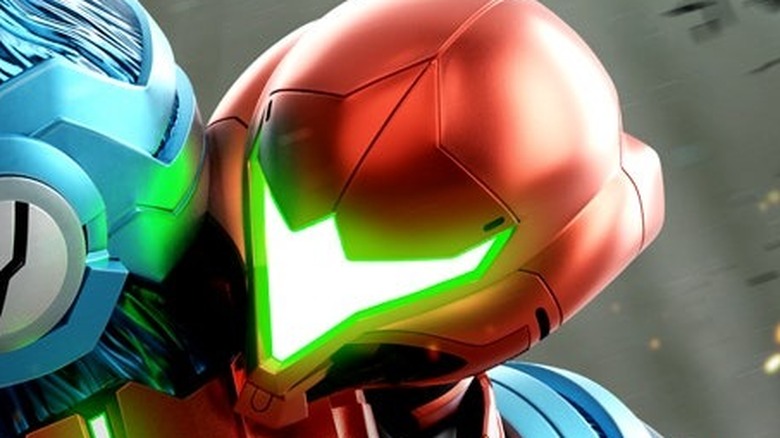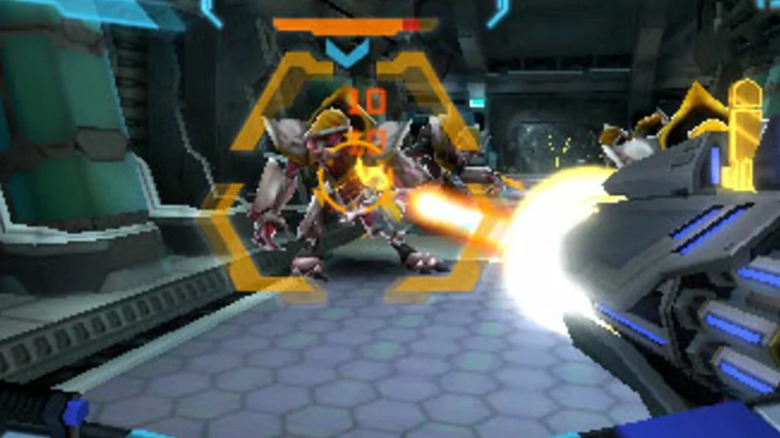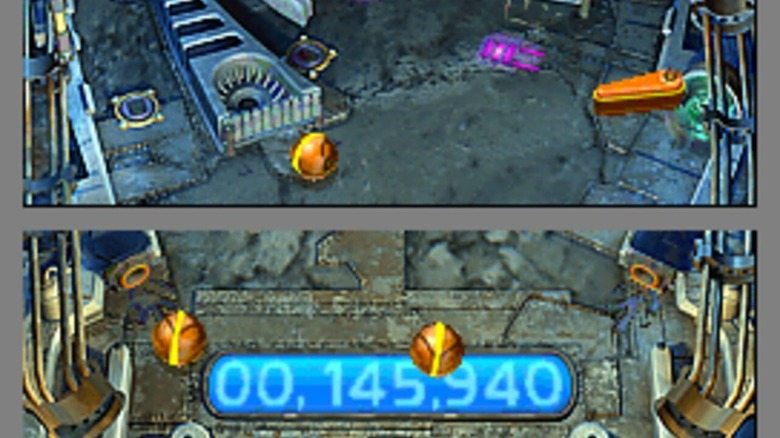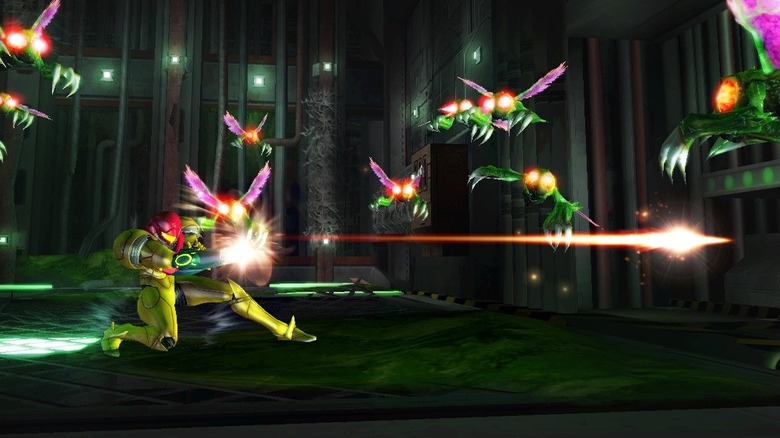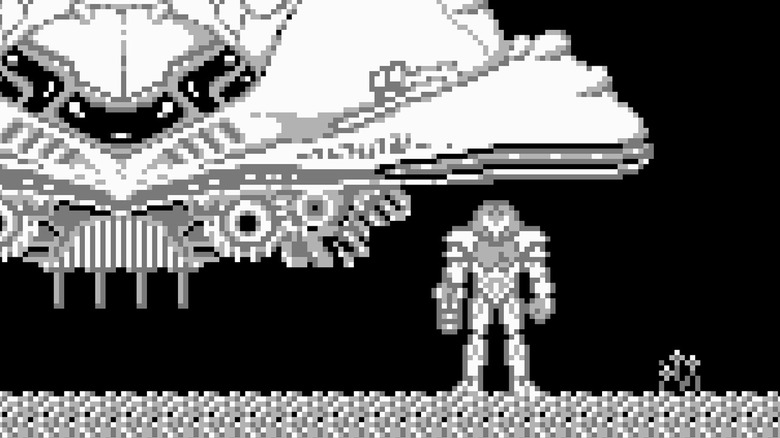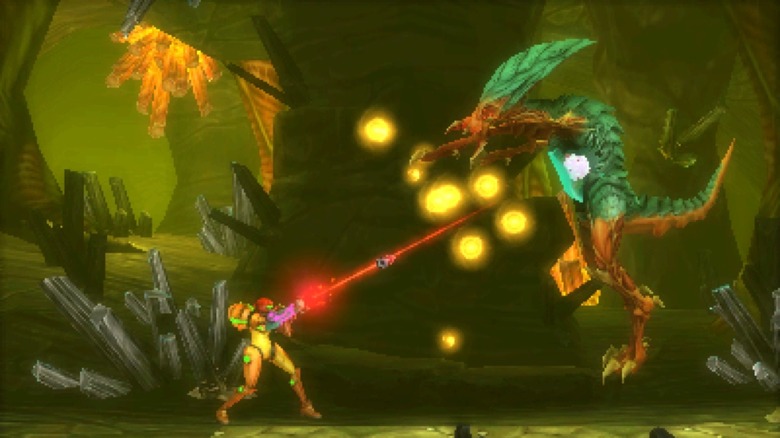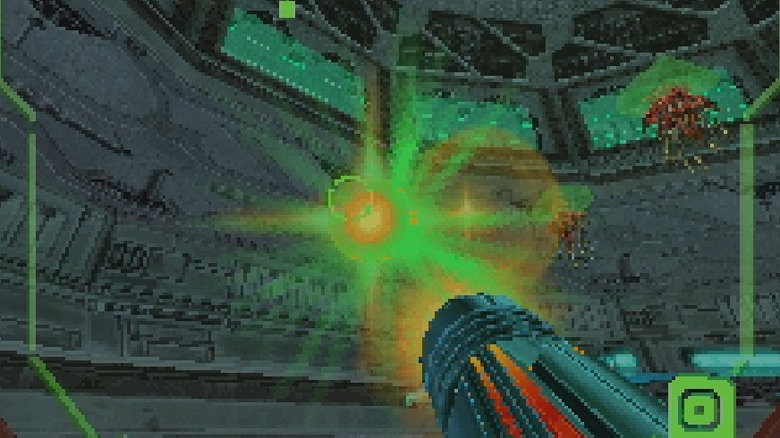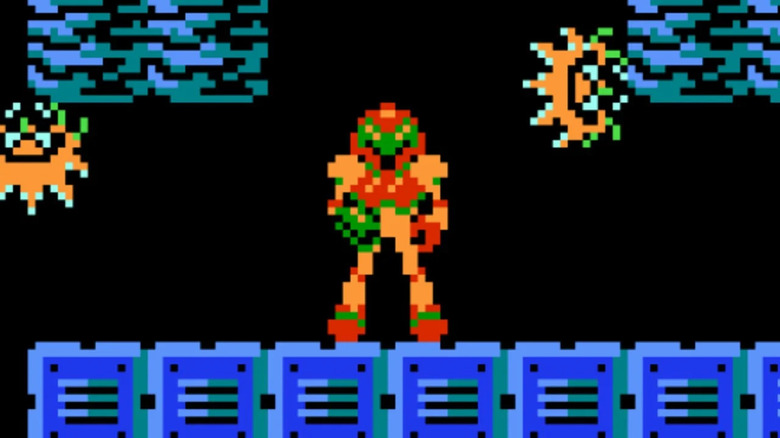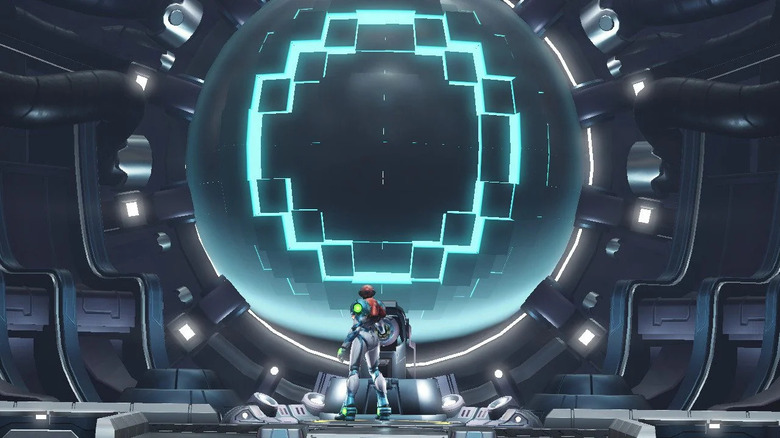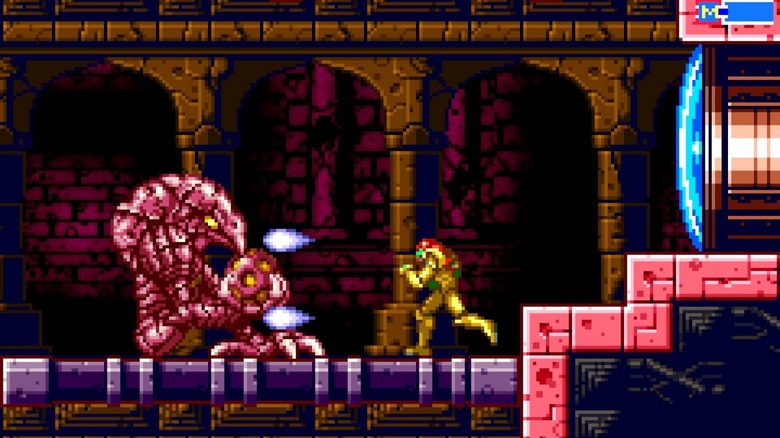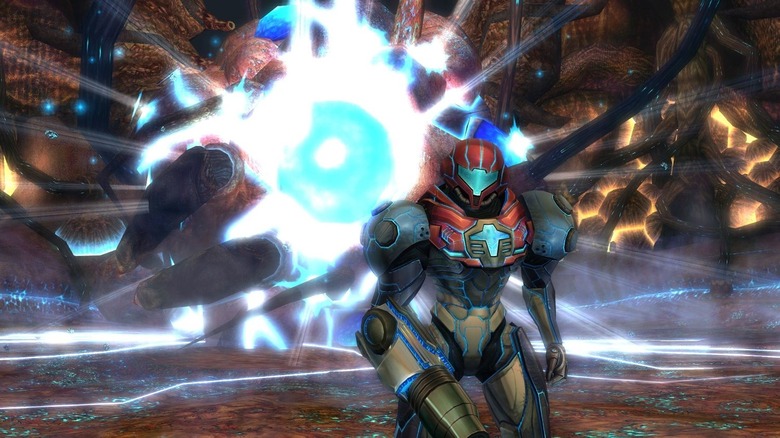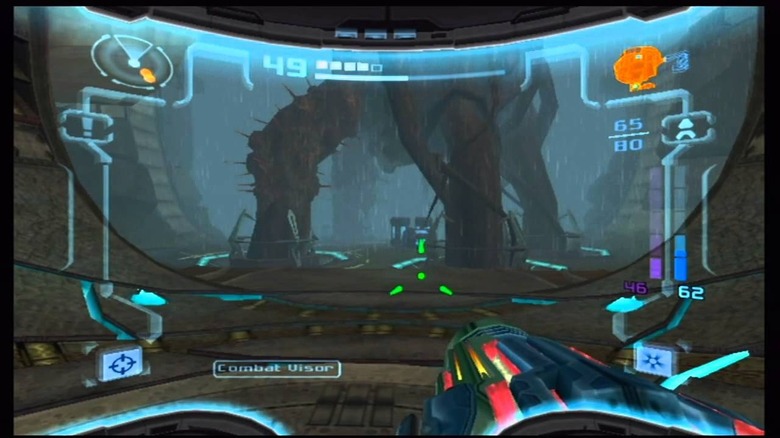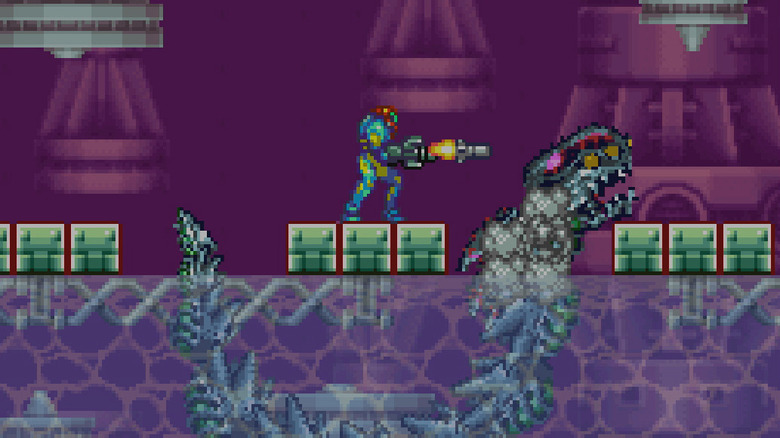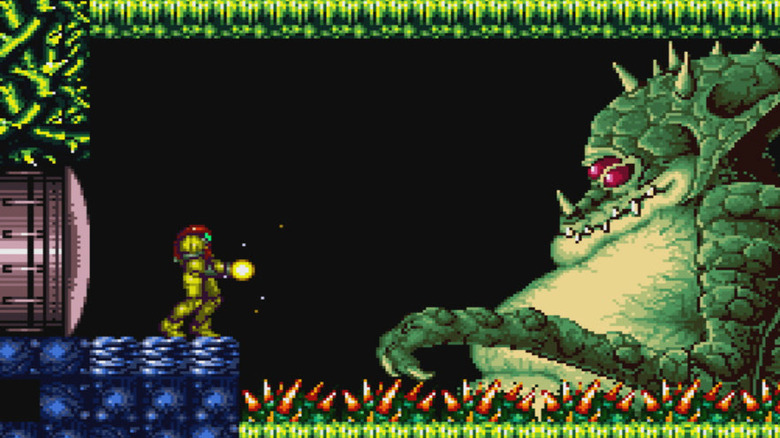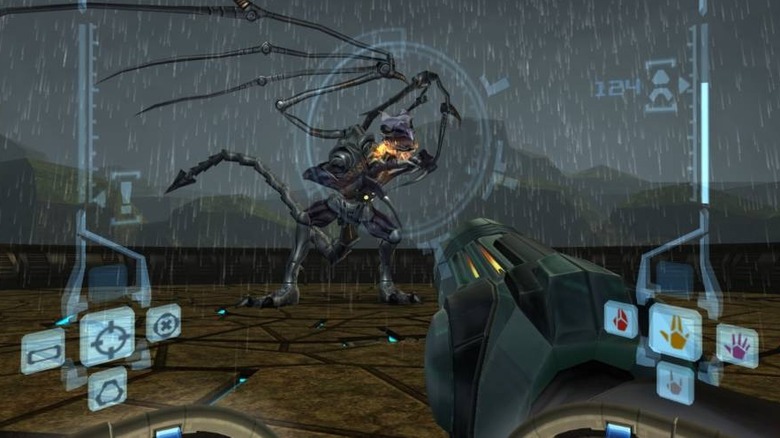Every Metroid Game Ranked Worst To Best
Established in 1986, science fiction action-adventure series "Metroid" spawned over a dozen entries across Nintendo's family of consoles and handhelds. Players remain eager to try on bounty hunter Samus Aran's Power Suit and lose themselves in the atmospheric world. It seems there's always another powerup to find or Space Pirate to take down.
Much like the video game industry, "Metroid" has transformed over the years. The franchise got its footing in the realm of third-person 2D side-scrollers, eventually breaking into first-person 3D action. While it has suffered a few missteps, each new entry built on the games that came before it, pushing boundaries and exploring new pathways. Thanks to the pioneer spirit of the developers, "Metroid" has consistently produced highly-rated follow-ups, even forging its own genre in the process.
Despite its impressive track record, not all "Metroid" titles are created equal. From worst to best, here's how every installment in the "Metroid" series stacks up.
14. Metroid Prime: Federation Force
Devotees who have long followed the "Metroid" series won't be surprised to find "Metroid Prime: Federation Force" at the bottom of the barrel. Nintendo unveiled the first-person co-op shooter via trailer at E3 2015, a move that sparked instant backlash. The video garnered thousands of dislikes and viewers railed against the title's focus on multiplayer, cartoonish graphics, and shift away from long-running protagonist Samus Aran. It didn't help that over five years had passed since "Metroid: Other M" hit the scene, or that players had not received a proper "Prime" game since "Corruption" in 2007. To further complicate matters, the "Federation Force" launch window bordered the franchise's 30th anniversary, a milestone Nintendo decided to celebrate with a spinoff that didn't look or play like a "Metroid" entry.
When "Federation Force" released, it confirmed fans' worst fears. IGN, Destructoid, and Polygon all took issue with the controls on the 3DS to varying degrees, citing a list of accompanying problems that included weak gunplay, uninspiring missions, tedious weight restrictions, and awkward Samus cameos. Perhaps the greatest sin proved to be the lack of balance between the single-player and multiplayer experiences. "When I tried to go in alone I found myself severely underpowered to the point where it simply wasn't any fun," wrote IGN's Jose Otero. Polygon reinforced this sentiment, stating, "'Federation Force”s disingenuous attempts to convince you that you can play it alone if you really want to are its biggest, most glaring issue."
A co-op game masquerading as a single-player "Metroid?" Much of the fandom said "no thanks" and left "Federation Force" to fade into obscurity.
- Release Date: August 19, 2016
- Available On: Nintendo 3DS
- Genre: First-Person, Shooter, Action, Arcade
- Game Modes: Single-Player, Online Multiplayer (Up to 4), Local Multiplayer (Up to 6)
- Metacritic Score: 64
13. Metroid Prime Pinball
Much like "Federation Force," "Metroid Prime Pinball" offers a rather untraditional take on the "Metroid" universe. As the name suggests, "Prime Pinball" boasts a "Metroid" flavored digital pinball setup, complete with flippers, ramps, bumpers, and spinners. The developer, Fuse Games, also threw in a few extras, such as roaming enemies and gunplay. The project originated with "Metroid: Prime Hunters" producer Kensuke Tanabe. "We thought, oh yeah, Samus becomes a ball!" Tanabe told IGN during an interview. "We went to Fuse to elaborate on the idea with Samus's abilities like her wall climbing and shooting."
The concept, while unexpected, went over well with most critics. GameSpot awarded "Metroid Prime Pinball" an 8.2, calling it a "faithful spin-off" with an attractive design that Fuse had injected with plenty of "Metroid" flavor. Similarly, Nintendo World Report praised the adaptation's frenetic pacing and addictive qualities, bolstered by "clever infusions of 'Metroid" gameplay."
The entry attracted more than sunshine and rainbows, however. Eurogamer pointed to several negatives, such as the inclusion of a rumble pack, which it referred to as "an embarrassing piece of kit." While its "Metroid" origins shone through, the reviewer felt the title failed to deliver on its pinball premise. "'Metroid Prime Pinball' is a game that requires that you're a bigger fan of the 'Metroid Prime' part of the title than you are of the 'Pinball' part," Eurogamer concluded, offering up an unimpressed 4/10.
- Release Date: October 24, 2005
- Available On: Nintendo DS
- Genre: Pinball
- Game Modes: Single-Player, Online Multiplayer (Up to 8)
- Metacritic Score: 79
12. Metroid: Other M
"Metroid: Other M" offers a bit of a mixed bag when it comes to "Metroid" titles. Set between the events of "Super Metroid" and "Metroid Fusion," it places players back in the shoes of Samus Aran as she explores a ramshackle space station. The game employs a 3D format and substantial cutscenes and voice acting to tell its sweeping story, while making extensive use of the Wii Remote to switch between third-person and first-person perspectives. "Other M" also introduced melee attacks to the franchise, offering up moves like Counter-attack, Lethal Strike, and Concentration.
Some reviewers, such as Craig Harris of IGN, appreciated how the combination of cinematics, narrative, and thrilling action in "Other M" shakes up the standard "Metroid" formula. GameSpot's Tom McShea was similarly smitten, praising the attractive environments, unique controls, and rewarding ship exploration. McShea identified the unskippable cutscenes as a key drawback — a recurring complaint from multiple sources.
Other outlets were much more critical of "Other M." A piece published on Destructoid slammed the title's "soap opera drama, inconsistencies, and dangling plot threads" and took aim at Samus' characterization, largely established through extensive monologues. G4 also decried how "Other M" portrays Samus: "In short, you're asked to forget that Samus has spent the last 10-15 years on solitary missions ridding the galaxy of Space Pirates, saving the universe and surviving on her own as a bounty hunter."
Viewed as both a game changer and combo breaker, "Metroid: Other M" remains one of the most polarizing entries in the series.
- Release Date: August 31, 2010
- Available On: Nintendo Wii
- Genre: Action-Adventure, Shooter, Third-Person
- Game Modes: Single-Player Only
- Metacritic Score: 79
11. Metroid 2: Return of Samus
"Metroid 2: Return of Samus" follows the titular protagonist in a race to eliminate the Metroids on planet SR388. The sequel built on the narrative, world, and gameplay established in the original "Metroid," establishing series staples like the Spazer Beam and Spider Ball in the process. Due to the constraints of developing for the Game Boy's black-and-white display, the developers also added rounded metal shoulders to Samus' Varia Suit to better distinguish it from her Power Suit (via IGN) — a detail that stuck around for successive entries.
Reviewers at IGN, Entertainment Weekly, and Nintendo Life felt "Return of Samus" did an excellent job building on the foundation created by its predecessor. "With its endlessly descending caverns and steep cliffs, its mazelike buildings and bizarre alien artifacts, 'Metroid II' gives you the feeling of being trapped in someone else's nightmare," wrote Bob Strauss, who, like the others, was drawn in by its massive world. The game's environments and soundtrack served as the main points of contention. Some critics praised the visual details, while others found the areas and enemies repetitive and difficult to distinguish. Similarly, the tunes and sound effects seem to inspire either love or hate. 1UP described the tracks as "downright painful." In contrast, IGN felt "the music [plays] at just the right times."
All and all, "Return of Samus" is a classic. However, gamers used to 3D "Metroid" titles may struggle to appreciate all it has to offer.
- Release Date: November 1991
- Available On: Game Boy
- Genre: Action-Adventure, 2D, Side-Scroller
- Game Modes: Single-Player Only
- GameRankings Score: 80.14%
10. Metroid: Samus Returns
As the names suggest, "Metroid: Samus Returns" is a remake of the 1991 Game Boy staple "Metroid 2: Return of Samus." Updated for the Nintendo 3DS, "Samus Returns" employs a 2.5D perspective, augmenting the original story with fresh visuals and mechanics. A melee counterattack, unrestrained aiming, fast travel, Aeion abilities, and Amiibo support all distinguished it from other 2D franchise entries. The overall experience resulted in a Best Handheld Game win at the 2017 Game Awards (via GameSpot).
Multiple critics praised the graphics in "Samus Retuns." Polygon called them the best "yet seen on the 3DS," while Andrew Webster of The Verge expressed his appreciation for the "wonderful sense of depth" created by the title's use of the "glasses-free 3D effect" on the handheld system. Overall, Webster was impressed by how developers MercurySteam and Nintendo EPD expanded on the source material, dishing out essential features, fluid gameplay, and thrilling brushes with death. Eurogamer found aspects of the reimagining less pleasing, calling it "an enjoyable if underwhelming remake" let down by somewhat gaudy aesthetics, messy controls, and combat mechanics that derail the pacing.
"Samus Returns" patched many of the flaws from "Metroid 2" but may have created a few new ones in the process.
- Release Date: September 15, 2017
- Available On: Nintendo 3DS
- Genre: Action-Adventure, 2.5D, Side-Scroller, Platformer,
- Game Modes: Single-Player Only
- Metacritic Score: 85
9. Metroid Prime: Hunters
"Metroid Prime Hunters" detours away from series signatures, instead placing the emphasis on first-person gunplay and its multiplayer modes. Several new bounty hunters join Samus, adding their own unique weapons and abilities to the mix. While still considered an adventure game, "Hunters" leans more strongly into action hallmarks, shedding past features like aim assist. The title includes a single-player campaign; however, the addition of a multiplayer component, complete with Wi-Fi and voice chat, makes "Hunters" stick out.
When "Metroid Prime Hunters" released, reviewers at GameZone and GamePro lauded its fantastic visuals, identifying it as one of the best looking games to appear on the Nintendo DS. Brett Elston of GamesRadar was blown away by the multiplayer options, comparing them to what you would find on a console game. 1UP generally shared this sentiment, though it questioned whether "Hunters" was truly a "Metroid" entry, stating, "'Hunters' naturally feels more like a regular FPS based in the 'Metroid' universe than a multiplayer game built around Metroid's unique gameplay characteristics."
The biggest complaints stemmed from the title's controls and repetitiveness, which IGN and Eurogamer both took shots at. This didn't stop "Hunters" from earning high marks and multiple awards, securing its spot on the list of top DS games. But does it really belong in the "Metroid" setting? That remains up for debate.
- Release Date: March 20, 2006
- Available On: Nintendo DS
- Genre: Action-Adventure, First-Person, Shooter, Arcade
- Game Modes: Single-Player, Online Multiplayer (Up to 4), Local Multiplayer (Up to 4)
- Metacritic Score: 85
8. Metroid
Released in the late '80s for the Nintendo Entertainment System, "Metroid" introduced bounty hunter Samus Aran and the parasitic Metroids. With its focus on exploration and collectible powerups, the action-adventure laid the groundwork for the Metroidvania genre and received additional attention as one of the first video games to feature a female main character. The developers drew significant inspiration from Ridley Scott's "Alien," and helped establish the concept of using powerful, persistent items to bolster characters and progress gameplay (per Retro Gamer. No. 65. Imagine Publishing. July 2009. p. 60).
Though reviewers like GameSpot's Bob Colayco have argued that "Metroid" hasn't aged well, citing unintuitive and frustrating level design, it still played a significant role in shaping the gaming industry. The title has received a number of ports to other systems, and you can see its mark on several other franchises, such as "Castlevania." Samus' gender reveal also served as an important milestone for the largely male-dominated world, "[blowing] the norm of women in pieces, at a time when female video game characters were forced into the role of dutiful queen or kidnapped princess" (via GameTrailers).
"Metroid" might be showing its age, but its legacy remains alive and well.
7. Metroid Dread
After keeping fans waiting for an original "Metroid" story for over a decade, Nintendo took the series back to its roots in 2021 with "Metroid Dread." Eschewing the 3D approach of the "Metroid Prime" titles, "Dread" offers up a nostalgic 2D side-scrolling experience while adopting well-received features established later in the lineup, like free aim and melee strikes. Not content to rest solely on the accomplishments of its predecessors, "Dread" also added stealth elements to the series, allowing Samus to evade detection as she surveys planet ZDR.
Critics showered "Metroid Dread" with praise, zeroing in on its atmosphere, pacing, soundtrack, and tough but satisfying combat. Eurogamer's Martin Robinson dubbed it an "Essential" title. "This is a game that really gets what makes Samus iconic," wrote Robinson. "Metroid Dread's Samus feels like a battle-hardened veteran, with a swagger in her step to match. It helps that this is the most dynamic Samus has felt in a Metroid game to date." Destructoid shared similar sentiments, though the outlet was less taken with the "disjointed map," lackluster zone transitions, and reportedly lifeless geography. While not a perfect or groundbreaking project, "Metroid Dread" is still a strong addition to the series and, by most accounts, worth the years of patience.
- Release Date: October 8, 2021
- Available On: Nintendo Switch
- Genre: Action-Adventure, 2D, Side-Scroller, Shooter
- Game Modes: Single-Player Only
- Metacritic Score: 88
6. Metroid: Zero Mission
"Metroid: Zero Mission" reimagines the 1986 "Metroid," weaving a new take on the original story bolstered by updated visuals and mechanics for the Game Boy Advance. Nintendo incorporated a host of new items, sections, and mini-bosses, along with the never-before-seen Chozodia area. "Zero Mission" further distinguished itself by stripping Samus of her Power Suit for a particular sequence — a franchise first — and delving into the bounty hunter's backstory.
Like many other "Metroid" titles, critics considered "Zero Mission" one of the best games released for its system. Describing "Zero Mission" as a "masterpiece," Nintendo World Report reviewer Jonathan Metts complimented the wealth of improvements and additions. In his eyes, the game felt more like a completely new entry than a true remake. "It takes all the best features and ideas from the entire 'Metroid' series, along with some significant new elements, and applies them to the game that started it all," concluded Metts. In fact, these innovations proved so successful that IGN, Eurogamer, and GameSpot all complained about its brief runtime. Simply put, players could not get enough of "Metroid: Zero Mission."
- Release Date: February 9, 2004
- Available On: Game Boy Advance
- Genre: Action-Adventure, 2D, Platformer
- Game Modes: Single-Player Only
- Metacritic Score: 89
5. Metroid Prime 3: Corruption
The third installment in the "Metroid Prime" subseries, "Corruption" evolved the IP in a number of ways. Built for the Nintendo Wii, it takes full advantage of the Wiimote and Nunchuk, splitting Samus' actions between them. Perfecting this system took the developers a full year to refine (via Gamasutra), while the additions of the souped-up Hypermode and the ability to summon and move Samus' gunship added further variety.
Overall, Nintendo's control scheme gamble paid off. "After playing 'Metroid Prime 3' you'll never want to play a shooter with dual analog controls again, it's that good," stated Shane Satterfield of GameTrailers. The graphical quality in "Corruption" also received significant attention from 1UP and IGN, with the latter handing the title an Editor's Choice Award. Described as "one of Wii's defining games," its controls, visuals, combat, puzzles, environment, voice acting, and cinematics combined to make it a suitable conclusion for "Metroid Prime," despite the fact that Nintendo has since started development on "Metroid Prime 4."
- Release Date: August 27, 2007
- Available On: Nintendo Wii
- Genre: Action-Adventure, First-Person, Shooter
- Game Modes: Single-Player Only
- Metacritic Score: 90
4. Metroid Prime 2: Echoes
"Echoes" continues the story of "Metroid Prime" and incorporates a few elements not seen in its predecessor. It unfolds across the parallel Light Aether and Dark Aether dimensions, symbolizing the classic "conflict between good and evil" (via IGN). This pervasive theme, along with a greater emphasis on narrative and cutscenes, gives the sequel a different feel than the original. The developers also opted for a higher difficulty level and incorporated features like wall jumping seen elsewhere in the franchise, in addition to a multiplayer component.
Nintendo's dedication to delivering a rich and detailed plot shone through. GameSpot and IGN highlighted its lengthy and rewarding campaign, bolstered by well-designed environments and tried-and-true components. Exhilarating boss fights, stimulating environmental puzzles, and a strong emphasis on discovery and exploration — it's all there, wrapped up in a 20-hour package. Though it found the multiplayer experience a bit of a letdown, Eurogamer ranked "Echoes" "among the best single-player experiences we've ever experienced," making it easy to see why "Metroid Prime 2" is considered one of top titles in the franchise.
- Release Date: November 15, 2004
- Available On: GameCube, Nintendo Wii
- Genre: Action-Adventure, First-Person, Shooter
- Game Modes: Single-Player, Local Multiplayer (Up to 4)
- Metacritic Score: 92 (GameCube)
3. Metroid Fusion
"Metroid Fusion" maintains the side-scrolling, platforming, exploration-based gameplay of previous series entries, though the addition of progression-guiding Navigation Rooms makes the experience a bit more linear. Nintendo also incorporated franchise firsts like ledge grabbing and ladder climbing and added animated cutscenes to better convey the story. Notably, Samus even sports a different suit design.
Upon release, "Metroid Fusion" proved a hit with critics. IGN praised the 12-hour runtime and the winning-if-predictable plot, giving particular attention to the title's gameplay and controls. The reviewer felt the developers did an excellent job utilizing the Game Boy Advance's four buttons, while also managing to deliver a memorable if understated soundtrack, despite the system's restricted sound capabilities. Tom Bramwell of Eurogamer called "Fusion" his "favourite 2D 'Metroid' yet," applauding its willingness "to toy with the 'Metroid' formula." The title manages to iterate without straying too far from the core of the IP, offering a fresh-but-familiar adventure for loyal followers of Samus Aran.
- Release Date: November 17, 2002
- Available On: Game Boy Advance
- Genre: Action-Adventure, 2D, Side-Scroller, Platformer
- Game Modes: Single-Player Only
- Metacritic Score: 92
2. Super Metroid
"Super Metroid" picks up after the events of "Metroid 2: Return of Samus," sending the bounty hunter to Zebes in pursuit of a pilfered baby Metroid. Like its predecessors, the 2D side-scroller emphasizes exploration and collecting powerups, though it threw several new ideas into the mix, such as multi-directional shooting. The developers entered the project intent on delivering a great action experience (per Game Players. Vol. 7 no. 5. May 1994. pp. 18–20), and bolstered the title with an inventory screen and automap. Offering a more polished outing than previous "Metroid" titles, "Super Metroid" helped spawn the Metroidvania movement (via GamesBeat).
As you might expect from a genre-creating game, "Super Metroid" received extensive accolades. Nintendo Life awarded it a 10/10, calling it "one of the greatest SNES games ever made." New elements, varied locations, smooth and approachable mechanics, pleasing graphics, and an impressive soundtrack all combine to create a classic gameplay loop. IGN described it as an "intense, moody adventure" that "you owe it to yourself as a gamer to finally find out about." The "Super Metroid" star has remained bright, with Joe Juba of Game Informer naming its ending "one of the most memorable and empowering moments in gaming history" nearly 20 years after the title released.
- Release Date: April 18, 1994
- Available On: Super Nintendo Entertainment System
- Genre: Action-Adventure, 2D, Side-Scroller
- Game Modes: Single-Player Only
- GameRankings Score: 96%
1. Metroid Prime
"Metroid Prime" marked a new direction for the franchise. In addition to kicking off a subseries, it was the first installment to adopt 3D graphics and a first-person perspective, thought it kept the emphasis on exploration. Set between "Metroid' and "Metroid 2," "Prime" follows Samus' encounters on Tallon IV as she snags powerups and collects key artifacts. The title features a more involved storyline than the entries that came before it, complete with brief cutscenes and background information delivered via text entries.
Multiple outlets awarded "Metroid Prime" perfect or near perfect scores, including IGN, Nintendo Power, GameSpot, and Game Informer. IGN called it "a must-have masterpiece" and "a real collector's item," praising its 30+ hour runtime, polished and action-packed gameplay, excellent puzzles, gorgeous graphics, and complimentary sound design. GameSpot expressed similar sentiments, asserting that "'Metroid Prime' doesn't play like any other game that's come before it." Smart controls and a sprawling world draw players into "one of the single most atmospheric games ever created."
Though billed as a first-person adventure, "Metroid Prime" left a lasting mark on the first-person shooter genre and even gained a significant following in the speedrunning community.
- Release Date: November 17, 2002
- Available On: GameCube, Nintendo Wii
- Genre: Action-Adventure, First-Person, Shooter
- Game Modes: Single-Player Only
- Metacritic Score: 97 (GameCube)

